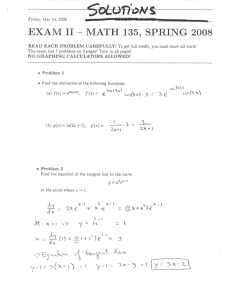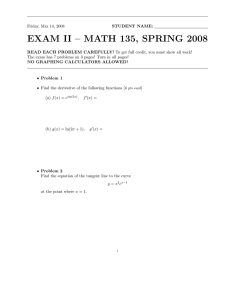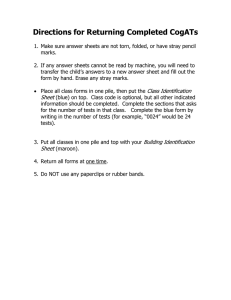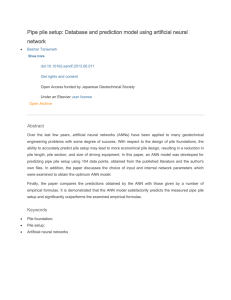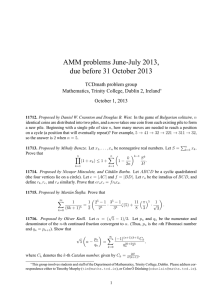RESEARCH Increasing Pile Driving Efficiency for Bridge Foundations
advertisement
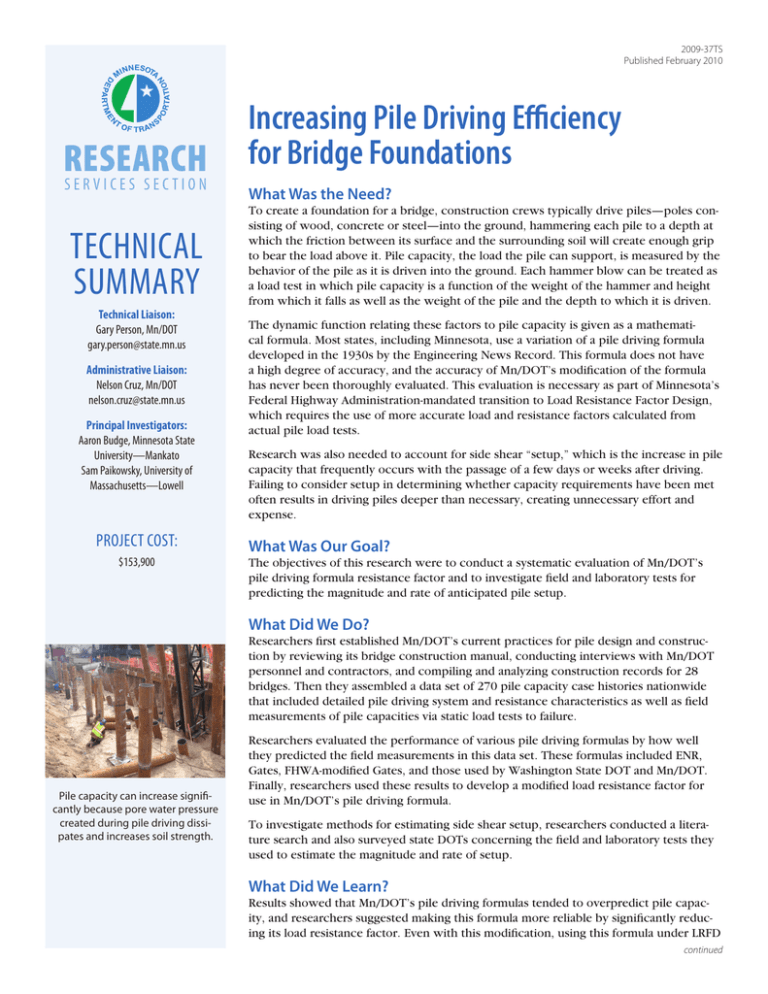
2009-37TS Published February 2010 RESEARCH SERVICES SECTION TECHNICAL SUMMARY Technical Liaison: Gary Person, Mn/DOT gary.person@state.mn.us Administrative Liaison: Nelson Cruz, Mn/DOT nelson.cruz@state.mn.us Principal Investigators: Aaron Budge, Minnesota State University—Mankato Sam Paikowsky, University of Massachusetts—Lowell PROJECT COST: $153,900 Increasing Pile Driving Efficiency for Bridge Foundations What Was the Need? To create a foundation for a bridge, construction crews typically drive piles—poles consisting of wood, concrete or steel—into the ground, hammering each pile to a depth at which the friction between its surface and the surrounding soil will create enough grip to bear the load above it. Pile capacity, the load the pile can support, is measured by the behavior of the pile as it is driven into the ground. Each hammer blow can be treated as a load test in which pile capacity is a function of the weight of the hammer and height from which it falls as well as the weight of the pile and the depth to which it is driven. The dynamic function relating these factors to pile capacity is given as a mathematical formula. Most states, including Minnesota, use a variation of a pile driving formula developed in the 1930s by the Engineering News Record. This formula does not have a high degree of accuracy, and the accuracy of Mn/DOT’s modification of the formula has never been thoroughly evaluated. This evaluation is necessary as part of Minnesota’s Federal Highway Administration-mandated transition to Load Resistance Factor Design, which requires the use of more accurate load and resistance factors calculated from actual pile load tests. Research was also needed to account for side shear “setup,” which is the increase in pile capacity that frequently occurs with the passage of a few days or weeks after driving. Failing to consider setup in determining whether capacity requirements have been met often results in driving piles deeper than necessary, creating unnecessary effort and expense. What Was Our Goal? The objectives of this research were to conduct a systematic evaluation of Mn/DOT’s pile driving formula resistance factor and to investigate field and laboratory tests for predicting the magnitude and rate of anticipated pile setup. What Did We Do? Researchers first established Mn/DOT’s current practices for pile design and construction by reviewing its bridge construction manual, conducting interviews with Mn/DOT personnel and contractors, and compiling and analyzing construction records for 28 bridges. Then they assembled a data set of 270 pile capacity case histories nationwide that included detailed pile driving system and resistance characteristics as well as field measurements of pile capacities via static load tests to failure. Pile capacity can increase significantly because pore water pressure created during pile driving dissipates and increases soil strength. Researchers evaluated the performance of various pile driving formulas by how well they predicted the field measurements in this data set. These formulas included ENR, Gates, FHWA-modified Gates, and those used by Washington State DOT and Mn/DOT. Finally, researchers used these results to develop a modified load resistance factor for use in Mn/DOT’s pile driving formula. To investigate methods for estimating side shear setup, researchers conducted a literature search and also surveyed state DOTs concerning the field and laboratory tests they used to estimate the magnitude and rate of setup. What Did We Learn? Results showed that Mn/DOT’s pile driving formulas tended to overpredict pile capacity, and researchers suggested making this formula more reliable by significantly reducing its load resistance factor. Even with this modification, using this formula under LRFD continued “Not only did researchers develop a new load resistance factor for the pile driving formula, but they went a step further in developing an entirely new formula that could lead to safer designs and potentially significant cost savings for Mn/DOT.” –Gary Person, Mn/DOT Foundations Engineer “Estimating the effects of setup in increasing pile capacity is a promising new area of research that could significantly reduce the effort and material costs involved in pile driving.” –Aaron Budge, Associate Professor, Minnesota State University—Mankato Department of Mechanical and Civil Engineering Produced by CTC & Associates for: Minnesota Department of Transportation Research Services Section MS 330, First Floor 395 John Ireland Blvd. St. Paul, MN 55155-1899 (651) 366-3780 www.research.dot.state.mn.us Construction crews need to drive piles deep enough to provide support for a bridge while not overdriving, which wastes resources. would involve increased effort and materials costs, so researchers also developed a new dynamic formula by performing a linear regression analysis on the data set used in this project. Then they compared the performance of this proposed new formula to that of the existing Mn/DOT formulas and showed that moving to the new formula would lead to more consistent results, which translate to safer designs and potential cost savings. Setup literature search results showed that side shear setup occurs in most soil types and with most types of piles, and can increase capacity from as little as 20 percent to as much as 800 percent. Factors causing setup can include the dissipation of pore water pressure generated during pile driving and consequent increase in soil strength with time, and the disturbance in soil surrounding piles caused by its displacement during driving. Survey results showed that while very few states are using field and laboratory tests to estimate setup, such methods are being investigated and show promise for application in the near future. What’s Next? Mn/DOT has funded an implementation project to collect pile driving field data and compare the results to those from recent research performed by other states. Researchers recommend a transition period in field practices of pile monitoring. The existing Mn/DOT equation using resistance factors (phi=0.40 for h-pile and phi=0.25 for pipe pile) should be examined against the new equation and the associated resistance factors (phi=0.6 for h-piles and phi=0.45 for pipe piles). A longer-term testing program of dynamic and, where possible, static load testing should be implemented to evaluate and review the proposed methodologies. Taking into account the effects of setup could significantly decrease the cost and effort involved in bridge construction. This Technical Summary pertains to Reports 2009-37, “Developing a Resistance Factor for Mn/DOT’s Pile Driving Formula,” published in November 2009, and 2009-38, “Study of Pile Setup Evaluation Methods,” published in December 2009. The full reports can be accessed at http://www.lrrb.org/PDF/200937.pdf and http://www.lrrb.org/PDF/200938.pdf, respectively.


